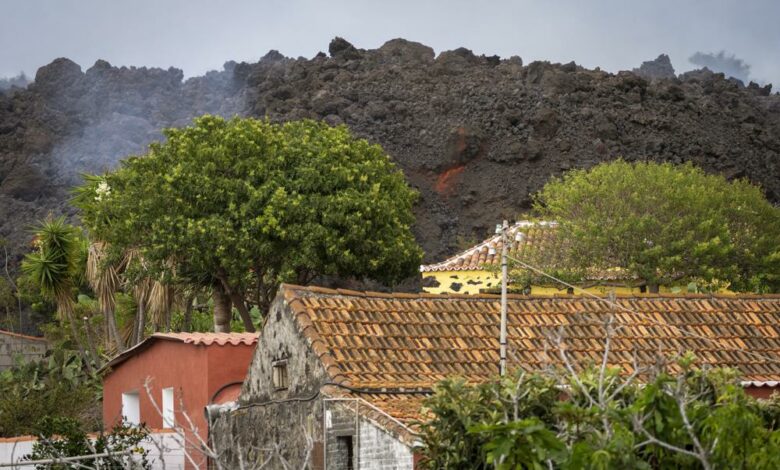
TODOQUE, Canary Islands (AP) — A wall of lava up to 12 meters (40 feet) high bore down on a Spanish village Wednesday as islanders scrambled to save what they could before the molten rock swallowed up their homes following a volcanic eruption.
The lava still spewing from Sunday’s eruption in the Canary Islands off northwest Africa advanced slowly down hillsides to the coast, where Todoque was the last village between the molten rock and the Atlantic Ocean.
The lava could take several days to cover the remaining 2 kilometers (1.25 miles) to the sea, experts said, but authorities and locals were taking no chances amid the unpredictable seismic activity.
Residents hoping to save some belongings queued up so they could be escorted into the village. The lava was advancing in the distance at around 120 meters (400 feet) an hour, with smoke coming from its leading edge as it destroyed everything it touched.
Javier López said his house for the past three decades appeared to be in the lava’s path. He and his relatives had been staying at a friend’s house with the few documents, photos and basic belongings they had been able to take when they were evacuated on Monday.
“I’ve put my whole life in a van,” López told The Associated Press as he waited for his turn to try to recover a vehicle he had left behind and other valuables.
“This is probably going to be the last time I see my home,” he said. “Or, in the best-case scenario, the house will remain isolated by the lava and inaccessible for who knows how long.”
Firefighting crews trying to save as many houses as possible from being entombed by lava worked nonstop overnight to open a trench to divert the lava flow.
Melisa Rodríguez, another Todoque resident, was trying to stay positive and calm.
“It’s hard to think straight about what you want to save, but we are only allowed in for one hour and you don’t want to take longer because that would be taking time away from others,” she said.
As the lava headed toward the island’s more densely populated coast, 1,000 people were evacuated late Tuesday from Todoque, bringing the total number of evacuated on the island of La Palma to over 6,800.
Authorities say more dangers lie ahead for residents, including more earthquakes, possible new lava flows, toxic gases, volcanic ash and acid rain. The lava, whose temperature exceeds 1,000 degrees Celsius (more than 1,800 F), could cause explosions, trigger landslides and produce clouds of toxic gas when it hits the ocean.
As volcanic ash fell over a wide area, authorities advised people to keep children inside as much as possible due to possible breathing difficulties.
The volcanic eruption and its aftermath could last for up to 84 days, the Canary Island Volcanology Institute said, basing its calculation on the length of previous eruptions on the archipelago, which like the latest eruption were followed by heavy lava flows and lasting seismic activity.
Tuesday night saw a sharp increase in the number of smaller eruptions that hurl rocks and cinders high into the air, it said.
The rivers of lava have swallowed up around 320 buildings so far, mostly homes in the countryside, and now cover 154 hectares (380 acres), the institute said. The lava has also ruined banana groves, vineyards and other crops. Prompt evacuations have helped avoid any casualties.
The volcano has also been spewing out between 8,000 and 10,500 tons of sulfur dioxide — which also affects the lungs — every day, it said.
Life on the rest of La Palma, which is roughly 35 kilometers (22 miles) long and 20 kilometers (12 miles) wide at its broadest point, has been largely unaffected, with undeterred tourists landing for previously scheduled holidays. Air traffic remained normal.
The Canary Islands are a popular destination for European tourists due to their mild year-round climate.
___
Barry Hatton contributed from Lisbon, Portugal.




